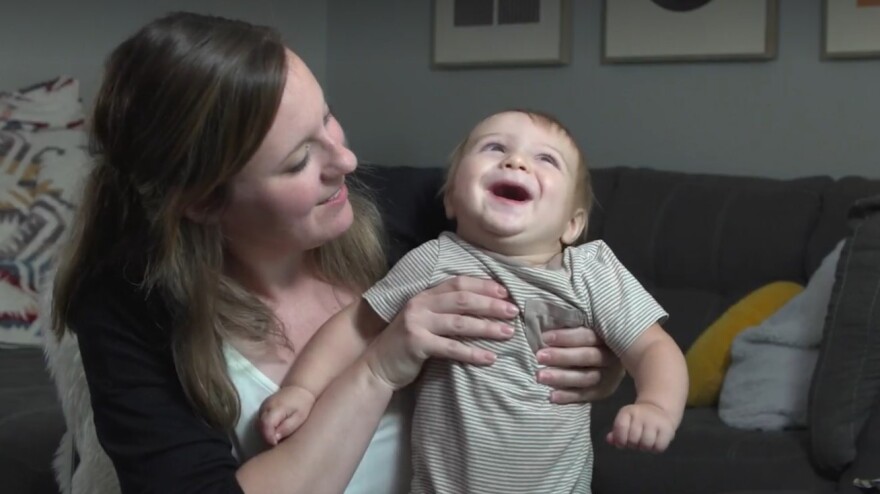Editor’s note: This is the second in a series of stories on children that Jackie Hendry, producer and host of South Dakota Public Broadcasting’s "South Dakota Focus," will write for South Dakota News Watch. Each month, she contributes a piece that previews the month's episode.
LEAD, S.D. – Companies are desperate for employees as the post-pandemic workforce continues to adjust. But when families can’t afford child care costs – or find an option that works for their schedule – someone often stays home.
Kids Count data from the Annie E. Casey Foundation shows 75% of South Dakota families with kids under the age of 6 have all parents working outside the home. In most cases, that’s an economic necessity for those families.
Considering South Dakota’s current historic rate of unemployment, any barrier to workforce participation is a matter of concern to the state’s economic future. This is especially true in high-demand fields like health care – and even child care itself.

'We’re here, but now we’re stuck'
Stephanie Wiegand is a registered nurse and her husband is a physician assistant. They moved to Lead with their four young children in the spring of 2020. She found one child care facility in neighboring Deadwood, but its hours didn’t fit their schedules.
“I had 12-hour shifts, (my husband) has 24-hour shifts … there was no way we could drop our kids off between these certain hours,” she explained.
Since the only nearby child care center didn’t meet their needs, Wiegand looked to family providers who offer child care from their homes. She looked to the state Department of Social Services’ online directory – and found nothing.
“I just learned recently, too, that not all day care providers have to register with the state,” Wiegand said. “That was also a little mind-blowing because the state I was in previously, it was more regulated.”
Registering with the state is voluntary for family child care providers with 12 or fewer children. The benefits of state registration include eligibility for grants and other assistance, but it also requires background checks and annual inspections. Unregulated family day cares can list themselves on the state's directory, but only a dozen in the whole state have done so — and none in Lead.
Since unregistered providers don't have that oversight, they also do not appear on the DSS online database of complaints. As a new resident, Wiegand was hesitant to trust her kids with unregulated in-home providers.
Wiegand’s sister and brother-in-law fared no better when they moved to Lead with their two kids a few months later. Wiegand’s sister also works in health care and starts her shifts at 5 a.m. Her brother-in-law teaches in another school district and leaves home around 6 a.m.
“No day care is opening up around that time,” Weigand said.
That was three years ago.
When the "South Dakota Focus" production team visited the Wiegands' home in August, Stephanie sat surrounded by six kids between the ages of 15 and 4. “I chose to stay home because I could not find day care in the area that was able to care for all these kiddos,” she said.
The Weigands moved here for job opportunities – answering an ongoing call from a variety of industries and the governor of South Dakota herself. What they discovered is a challenge that faces nearly every family in the state: finding care they can trust and afford.
“We’re here, but now we’re stuck,” said Weigand. She explained she’s able to pick up an occasional nursing shift now that most of the kids are school-aged, but she had no choice but to stay home for the first two years living in Lead.
“I even took care of somebody’s infant for six to seven months after they were born because they could not find child care,” she added. “And that was two people that also worked at the hospital that my husband works at. So this is not something abnormal to people just moving in. They were locals that had lived here for 20 years and knew everybody in the area.”
Weigand knows many other nurses who face the same difficult decision, and she worries about the impact that has on the overall health care industry.
“We know that there is a shortage within the big hospitals as well as the community, small-town hospitals. This has caused a lot of these places to hire a lot of travel nurses,” Weigand said.
Travel nurses tend to cost hospitals much more than a permanent position, which can in turn put struggling rural hospitals in a deeper financial hole. But other industries stand to lose out on workers too.
“You look at the region as a whole here, in the Lead-Deadwood area, there’s a lot of shift workers at the casinos. There’s a lot of shift workers at the (Homestake) mine,” Weigand said. “Chances are probably both of the spouses working shift work. It’ll happen. And so those are the ones that are really struggling if they have young kids.”

'I would have paid over $27,000 to have both these kids in child care'
Even if parents can find child care that suits their family’s schedule, the cost of care per child is prohibitive for many.
In Sioux Falls, RiAnna Kolovsky also stepped away from her career to care for her kids, 2-year-old Sylvi and 11-month-old Wolfgang.
“Child care was just not feasible,” she said. “This year I would have paid over $27,000 a year to have both of these kids in child care. Granted, it’s a good center, and it had accreditation outside of regular state accreditation. But what job can you work that makes that feasible? The State Department of Health says that for a median income for the state of South Dakota that we shouldn’t pay hardly any more than $9,000 a year. Most families in the state pay at least ($10,000) per kid.”
Kolovsky understands the issue better than most because she used to work in child care. She even helped families search for payment assistance opportunities. Few qualify for government subsidies. And fewer still can manage the complexities of the application.
“You have to use it at a place that has state licensure,” she said as an example. “So there’s another thing. Say you are a family that you have that child care assistance, but the only place in your hometown is an in-home day care that’s not licensed. What do you do then?”
Kalovsky left her job in a child care center to care for her own children, but the profession also faces dismal retention rates due to poor wages that have not kept up with other fields. In 2021, the turnover rate of child care providers in South Dakota was more than 85%.
Today, Kalovsky is a stay-at-home mom. Since she doesn’t have a typical day job, she’s able to take advantage of kid-friendly programs at the local library and other resources in Sioux Falls to keep her kids engaged and to connect with other parents.
But because her family is down to just one income, they’ve been priced out of their rental property. Now they’re moving 60 miles away to small-town Ethan, where her husband’s family has a house and job waiting for them.
“I don’t see a lot available in the region. And that does make me a little bit anxious,” Kalovsky said. “How am I going to endure the winter – long winter – with two kids at home?”
Since leaving her job, Kalovsky has connected with other frustrated parents from around the country through online discussion groups. They’ve created the grassroots Campaign for Childcare to push for reform at the state and federal levels.
“I don’t advocate for child care so I can go back to work,” she said. “I do it so my daughter doesn’t have to choose between a career that she probably will have invested in like I have. Four years of education and student loans to now not be doing that because it’s not worth it. ..."
Kalovsky trails off as her daughter brings her a toy to hold.

'When you talk about child care as a workforce issue, people listen'
Republican state Rep. Taylor Rehfeldt of Sioux Falls is well-aware of the cost-barrier to child care her constituents face, though neither she nor her husband has had to leave the workforce.
“My daughter, Tallie, she is going to day care in about six to ten weeks,” Rehfeldt said in August, “and it’s $275 dollars per week. So it’s $1,100 dollars per month to send our one child to child care. And then we have before- and after-school care for our other two children, which is about $150 to $200 dollars per week. So, we’re looking just at $2,000 per month in child care expenses. Now, we’re lucky and fortunate that both of us are nurses and we have an income that is supportive of that. But we all know that most people can’t afford that. And $24,000 a year is not attainable for most families to be able to pay.”
Rehfeldt was among lawmakers who supported a legislative interim study on child care after this year’s session. These studies bring lawmakers and experts together, and often result in proposed law changes. However, the executive board that decides on study topics chose different areas this year, in part because the issues surrounding child care are so broad.
“From a policy standpoint of what I think the Legislature’s responsibility is, I think we can explore some things that make life easier for day care centers and in-home centers,” Rehfeldt said.
“I think we could look at how we are subsidizing child care, and is that still accurate from a standpoint of income? Or do we need to look at expanding that a little bit or do we need to look at business partnerships where businesses could be rewarded for their investment into child care?"
We're looking just at $2,000 per month in child care expenses...We all know that most people can't afford that. And $24,000 a year is not attainable for most families to be able to pay.Republican state Rep. Taylor Rehfeldt of Sioux Falls
Rehfeldt is far from the only lawmaker who sees that something needs to change. In lieu of a legislative study, Brookings Republican Sen. Tim Reed is leading a group looking into the issue. He’s also CEO of the Brookings Economic Development Corp.
“The No. 1 thing I think we have to do is figure out how we’re gonna raise the rates that are being paid (to child care providers),” Reed said during South Dakota Public Broadcasting's town hall on child care. “And I think that’s gonna be the government taking a look at how we’re subsidizing, and then also – and it’s been talked about – businesses are gonna have to get involved and realize that they’re gonna have to pay more if they want these employees.”
However, Reed notes projected state revenues are not as lush as they’ve been in recent years thanks to the influx of federal pandemic relief monies. But Rehfeldt believes there's an appetite among her colleagues in Pierre to address the issue as it continues to gain attention.
“When you talk about child care as a workforce issue, people listen,” she said.
The next episode of South Dakota Focus airs on Thursday, October 26, at 8 p.m. Central time / 7 p.m. Mountain time. It can be viewed on SDPB-TV-1, Facebook, YouTube and SD.net.




